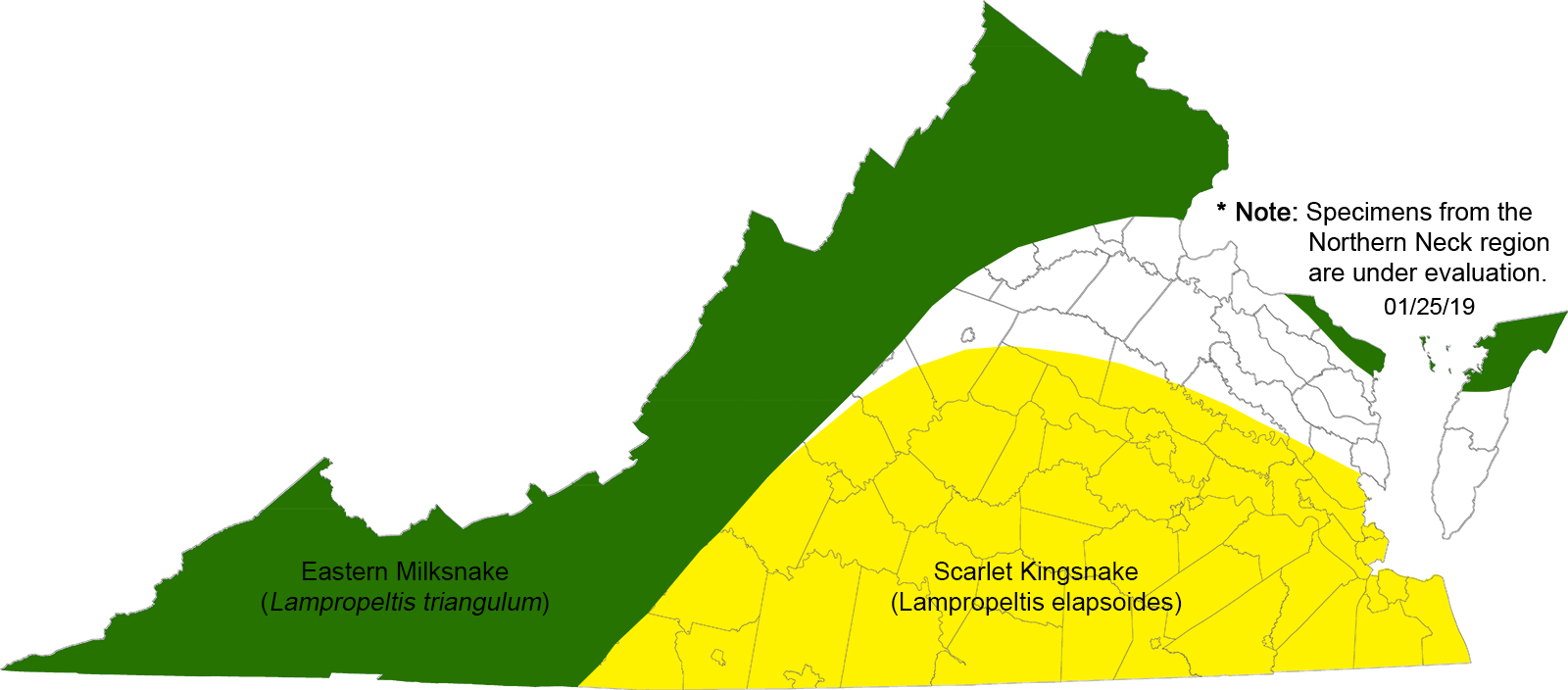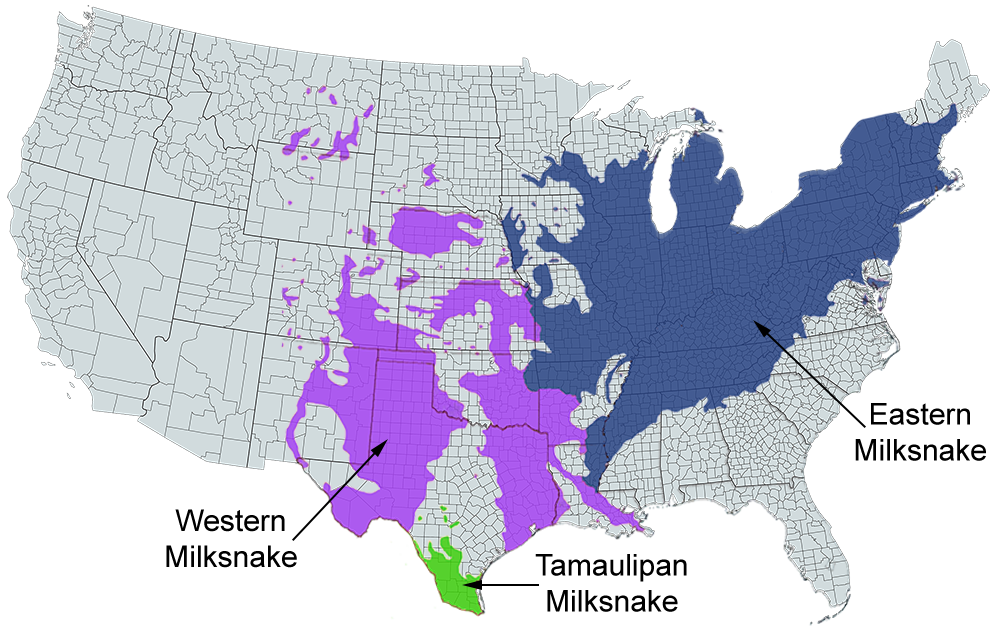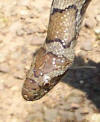Eastern Milksnake
Lampropeltis triangulum
** Harmless **
Common Name: |
Eastern Milksnake |
Scientific Name: |
Lampropeltis triangulum |
Etymology: |
|
Genus: |
Lampropeltis is derived from the Greek words lampros which means "radiant" and pelta meaning "small shields". |
Species: |
triangulum is derived from the Latin word triangulus which means "having three angles". |
Vernacular Names: |
Adder, chin snake, checkered adder, chicken snake, cow-sucker, highland adder, house moccasin, leopard-spotted snake, milk sucker, sand-king, sachem snake, thunder-and-lightning snake |
Average Length: |
24 - 36 in. (61 - 90 cm) |
Virginia Record Length: |
42.2 in. (107.3 cm) |
Record length: |
52 in. (132.1 cm) |
PHYSICAL DESCRIPTION: The Eastern Milksnake has a tan or gray ground color and three to five rows of reddish-brown, black-edged dorsal blotches. The center row of blotches is the largest and alternates with smaller lateral blotches. There is a gray or tan Y- or V-shaped mark usually present at the rear of the head. The belly is whitish with squarish black blotches giving a checkerboard effect. Albino individuals may be seen. Juveniles are similar to adults but have much redder blotches. Ths species is 6 inches at birth and grows to about 4 feet. Most adults are from 24-36 inches long *1006*. In Virginia, maximum known SVL is 940 mm (37.0 inches) and maximum total length is 1073 mm (42.2 in). Outside Virginia, the record length is 52 inches. *11523*.
COLORATION and PATTERN: Two primary color-pattern combinations occur, blotched phase and banded phase, along with intermediates. 1) Blotched phase: dorsum brown to gray, variously peppered in black, with a series of brown to reddish blotches; each blotch slightly wider than long and nearly surrounded by black; body blotches number 26-46 (avg. = 33.5, n=80); blotch on dorsum of head longer than those on body and usually pointed anteriorly, often with a Y-shaped open center surrounded by black pigment; this pattern varies and the blotch may be open on one side or broken into several smaller blotches; irregular eye-jaw stripe of brown or red and black extends past margin of mouth; a dorsal crossbar of similar color lies between and slightly anterior to the eyes; small, irregular black blotches alternate with the dorsal blotches on the sides; venter with black and white checkerboard pattern, the white is usually peppered with black; chin white, several or all of the white supralabials outlined in black; red coloration fades to brown in alcohol but otherwise specimens in preservative are as described. This is a moderate-sized snake with a blunt head only slightly wider than the neck. Dorsal scale rows usually 19-21 and temporal scale formula usually 2+3/2+3. (2) Banded phase: 14-20 (avg. = 16.1+/-1.9, n=12) red rings separated from yellow rings by black rings; dorsum of head red, separated from yellow crossband on neck by a black crossband that lies across the posterior margin of the parietal scales; ventral pattern consists of the continuation of the alternating red, black, and yellow rings, particularly anteriorly; rings do not completely encircle body but break up before meeting at the midline; posteriorly along the midline, a wide black stripe, usually broken with white along the midline, separates the body bands; chin, infralabials, and supralabials white; red color fades to brownish in preservative and yellow fades to cream. Dorsal scale rows usually 19 or 21 and temporal scale formula usually 1+2/1+2 or 2+2/2+2. (3) Intermediates: red, yellow, and black rings not distinct but forming blotches that partly or nearly encircle the dorsum; dorsum of head brownish or reddish with irregular black crossband or broken reddish brown blotch; remnants of bands on venter with irregular white spaces at the midline or with irregular black and white checkerboard pattern. Dorsal scale rows are usually 19 or 21 and temporal scale formula 1+2/1+2, 2+2/2+2, 2+3/2+3, or combinations of these.*10760*
SEXUAL DIMORPHISM: Because of the wide range of variation in morphometrics, pattern, and scutellation in this species, sexual dimorphism is compared between L.t. triangulum in montane samples (Blue Ridge and Ridge and Valley) and interglades in the Piedmont and Coastal Plain (including Loudoun and Clarke County specimens). (1) Lampropeltis t. triangulum: Average adult male SVL (737.6+/-105.3 mm, 570-940, n=32) is larger than average SVL for adult females (640.1+/-79.3 mm, 523-765, n=12), and reach a larger total length (1073 mm) than females (878 mm). Sexual dimorphism index is -1.15. The number of subcaudal scales is higher in males (41-53, avg = 46.3+/-2.9, n=39) than females 29-49, avg. = 41.5+/-5.5, n=20), as is the number of ventrals + subcaudals (males 228-251, avg. = 240.2+/-6.2, n=38; females 214-256, avg. = 234.1+/-9.5, n=20). The number of ventral scales (males 186-202, avg. = 193.5+/-4.8, n=50; females 185-210, avg. = 193.2+/-6.4, n=23) and body blotches (males 27-46, avg. = 33.8+/-4.3, n=54; (2) Lampropeltis t. triangulum x elapsoides intergrades: Adult males average larger (539.0+/-205.6 mm, 340-902, n=9) than adult females (387.5+/-96.2 mm, 318-523, n=4), and reach a larger total length (males 1041 mm, females 598 mm). Sexual dimorphism index is -1.39. The average number of subcaudal scales in males (40-50, avg. = 44.9+/-3.3, n=13) is higher than in females (37-42, avg. = 39.5+/-1.7, n=13), as is the number of ventrals + subcaudals (males 214-248, avg. = 230.5+/-12.6, n=13; females 212-244, avg. = 224.9+/-9.5, n=12). The number of ventral scales (males 173-201, avg. = 185.8+/-9.7, n=13; females 174-203, avg. = 184.7+/-8.7, n=11) and body bands (males 14-34, avg. = 23.9+/-7.5, n=15; females 14-36, avg. = 22.2+/-6.8, n=13) are similar between sexes.*10760* Juveniles: Juveniles of each of the subspecies look like the adults characteristic of the area but the colors are brighter. Juveniles from the mountains have reddish blotches. At hatching, juveniles of L.t. triangulum are 170-200 mm SVL (avg. = 181.7+/-10.1, n=11), 198-229 mm total length (avg. 209.8+/-11.1), and weigh 3.8-4.3 g (avg = 4.1+/-0.3). Hatchings of L.t. triangulum x elapsoides intergrades from North Carolina are 140-188 mm (avg. = 165.6) total length.*10760*
CONFUSING SPECIES: This species may be confused with P. guttata in the western part of Virginia, however, the corn snake has a longer head, a longer eye-jaw stripe, no peppering in the white on the venter, and is shaped like a bread loaf in cross section. In southeastern Va., this snake may be confused with Cemophora coccinea which has red blotches, an elongated snout, and an unpatterned white venter.
GEOGRAPHIC VARIATION: This species exhibits the most extreme geographic variation in body size, pattern, and color of any Virginia snake. The blotched pattern (described above) is confined to the higher elevations in and west of the Blue Ridge Mountains. The pattern of nearly complete body bands is found in southeastern Virginia, and the intermediate patterns in the Piedmont and parts of the Blue Ridge Mountains north of the James River. Snakes in the Coastal Plain and southeastern Piedmont more closely resemble the form with encircling body bands, whereas snakes in the northern half of the Piedmont usually have variations of the blotched form.
REPRODUCTION: This species is oviparous. The females usually deposit between 4-12 eggs in rotting wood and beneath rocks and logs. Some eggs may be buried several inches deep in the soil. The creamy-white slender eggs are usually laid in the early summer. Most of the eggs adhere to one another. The eggs hatch after 2-2 1/2 months with the newborn individuals ranging from 4-8 inches in length *1006*. Egg number and size depends on the size of the female, this is partly a consequence of geographic origin in Virginia. Generally, mating takes place in spring, eggs are laid in June and July, and hatching occurs in August and September. Eggs are laid in rotting logs and stumps, under rocks, and in sawdust piles. In Va., the smallest adult female L.t. triangulum was 523 mm SVL and the smallest L.t. triangulum x elapsoides female was 318 mm SVL. A female L. triangulum from Highland Co. laid 12 eggs on 23 June which hatched on 15-16 August. Eggs averaged 31.2+/-1.4 x 16.3+/-1.0 mm (length 28.9-33.4, width 13.6-17.5) and weighed 3.3-5.3 g (avg = 4.8). Williams reported clutch sizes of 5-20 for L.t. triangulum. No data on reproduction in Virginia L.t. triangulum x elapsoides intergrades are available. Palmer and Braswell reported clutch sizes of 3-7 eggs that averaged 28.8x 11.1 mm. Miller and Grall found that hatching intergrades from Maryland were 191-197 mm total length.*10760*
BEHAVIOR: This is a secretive snake that is often found beneath rocks, logs, stumps and boards. This species is a burrower and spends much of its time beneath the ground.
PREY ITEMS: This species consumes mammals —shrews (Blarina brevicauda, B. hylophaga, Cryptotis parva), mice (Mus musculus, Peromyscus leucopus, P. maniculatus, Zapus hudsonius), and voles (Clethrionomys gapperi, Microtus ochrogaster, M. pennsylvanicus, M. pinetorum); birds — boobies (Sula leucogaster, S. nebouxii), sooty tern (Sterna fuscata), chipping sparrow (Spizella passerina), phoebe (Sayornis phoebe), and ovenbird (Seiurus aurocapillus), and their eggs—sparrow (Emberizidae), brown-headed cowbird (Molothrus ater), and American robin (Turdus migratorius); reptiles — lizards (Anolis carolinensis, Cnemidophorus angusticeps, C. costatus, C. sexlineatus, Ctenosaura pectinata, Eumeces fasciatus, E. inexpectatus, Sceloporus graciosus, S. occidentalis, S. undulatus, Scincella lateralis), snakes (Agkistrodon contortrix, Carphophis amoenus, C. vermis, Crotalus sp., Diadophis punctatus, Lampropeltis triangulum, Leptotyphlops sp., Liochlorophis vernalis, Nerodia sipedon, Regina septemvittata, Storeria dekayi, S. occipitomaculata, Tantilla coronata, Thamnophis radix, T. sirtalis, Virginia striatula, V. valeriae), and reptile eggs (Diadophis punctatus, Lampropeltis triangulum); amphibians — frogs and toads (Anaxyrus sp.) and salamanders; fish — minnows (Cyprinidae) and killifish (Fundulidae); earthworms (Annelida); slugs (Mollusca); insects — beetles (Coleoptera), caterpillars (Leptidoptera), and roaches (Orthoptera) (Anderson 1965; Ashton and Smith 1999; Brown 1979b; Carr 1940; Collins 1993; C. Ernst, pers. obs.; Fitch 1999; Fitch and Fleet 1970; Guidry 1953; Hammerson 1986; Kamb 1978; Klemens 1993; Medsger 1922; Mitchell and Groves 1993; Palmer and Braswell 1995; Rodriguez and Drummond 2000; Skehan 1960; Surface 1906; Tennant 1985; Vermersch and Kuntz 1986; Uhler et al. 1939; Williams 1988). That L. triangulum eats venomous pit vipers is not surprising, as its blood serum has venom-neutralizing properties (Weinstein et al. 1992). Some prey are consumed as carrion; C. Ernst observed a L. t. triangulum eating a road-killed Blarina brevicauda in Pennsylvania.
Small mammals are the preferred prey. They made up 79% of the food volume and 68% of all items (59% were young). Birds made up 12.7% of food volume (19% frequency) and reptiles 8.1% of food volume (12.4% frequency) in milksnakes examined by Brown (1979b). Uhler et al. (1939) found mice made up 42% by volume, snakes 26%, song birds and their eggs 16%, insects 11%, and shrews 5% of the stomach contents of Virginia L. triangulum containing food.
POPULATION PARAMETERS: The maximum known age is 21 years 4 months and 18 days *1006,11523*. Lampropeltis triangulum are more common in the mountains than in the Piedmont and Coastal Plain.*10760*
AQUATIC/TERESTRIAL ASSOCIATIONS: Potential predators include opossums, skunks, and raccoons *1006*. Known natural predators of L. triangulum outside of Virginia are bullfrogs (Lithobates catesbeiana) mad brown thrashers (Toxostoma rufum). Humans kill many individuals on the highways and through destruction of habitat.*10760*
References for Life History
Photos:
*Click on a thumbnail for a larger version.
Verified County/City Occurrence in Virginia
Accomack
Albemarle
Alleghany
Amherst
Appomattox
Arlington
Augusta
Bath
Bedford
Bland
Botetourt
Clarke
Craig
Dickenson
Fairfax
Fauquier
Floyd
Fluvanna
Franklin
Frederick
Giles
Grayson
Greene
Highland
Lancaster
Lee
Loudoun
Madison
Montgomery
Nelson
Northumberland
Page
Patrick
Prince William
Pulaski
Rappahannock
Roanoke
Rockbridge
Rockingham
Russell
Scott
Shenandoah
Smyth
Tazewell
Warren
Washington
Wythe
CITIES
Alexandria
Charlottesville
Manassas
Winchester
Verified in 47 counties and 4 cities.
* PLEASE NOTE: Due to recent genetic work on Lampropeltis triangulum (Eastern Milksnake) and Lampropeltis elapsoides (Scarlet Kingsnake) the below map depicts the currently known distributions of these species. Although their ranges overlap along the eastern slope of the southern Blue Ridge Mountains, there is no genetic evidence indicating the two species interbreed.

U.S. Range

003_small.jpg)




